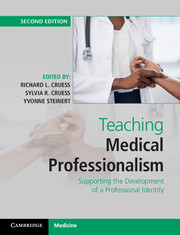Book contents
- Frontmatter
- Contents
- List of contributors
- Foreword
- Introduction
- Part I What is to be taught and learned
- Part II Theory
- 3 Theoretical insights into the nature and nurture of professional identities
- 4 Socialization, professionalism, and professional identity formation
- 5 Educational theory and strategies to support professionalism and professional identity formation
- 6 Role modeling and mentoring in the formation of professional identity
- 7 Experiential learning and reflection to support professionalism and professional identity formation
- Part III Principles
- Part IV Case studies in promoting professionalism and professional identity formation across the continuum
- Part V The future
- Index
- References
7 - Experiential learning and reflection to support professionalism and professional identity formation
from Part II - Theory
Published online by Cambridge University Press: 05 April 2016
- Frontmatter
- Contents
- List of contributors
- Foreword
- Introduction
- Part I What is to be taught and learned
- Part II Theory
- 3 Theoretical insights into the nature and nurture of professional identities
- 4 Socialization, professionalism, and professional identity formation
- 5 Educational theory and strategies to support professionalism and professional identity formation
- 6 Role modeling and mentoring in the formation of professional identity
- 7 Experiential learning and reflection to support professionalism and professional identity formation
- Part III Principles
- Part IV Case studies in promoting professionalism and professional identity formation across the continuum
- Part V The future
- Index
- References
Summary
At times I felt like a thief because I heard words, saw people and places – and used it all in my writing…. There was something deeper going on, though – the force of those encounters. I was put off guard again and again, and the result was – well, a descent into myself.
When I (TAH) was a first-year resident in internal medicine, my wife and I attended a New Year's Eve party given by some English people whom we had met recently. We were new immigrants to Canada and so were they, and I suppose we were trying to assuage our mutual loneliness and longing for home. There were a lot of people at the party whom we did not know. We were standing at the edge of a room when we were approached by a man in his sixties. He was interested, interesting, and charming. He, like our hosts, was also from England but had been in Canada much longer. We felt cared for in the safe embrace of his conversation. We talked with him for over an hour and had a wonderful evening. I remember thinking after we left the party, “What a delightful man,” and how much he had contributed to us that evening.
One week later, I was on call for the Cardiac/Respiratory Care Unit, receiving sign-over with my senior resident. Various patients were signed out. This one had an inferior myocardial infarction and some arrhythmias; that one had had an episode of pulmonary edema. The last patient to be signed out was a man in his 60s with COPD due to many years of smoking, recurrent episodes of pneumonia and respiratory failure, a probable problem with alcohol, and a history of psychiatric illness. He was now in with pneumonia and respiratory failure, and the clear message was not to try too hard. If we lost this one, the world would not be much worse off. I was doing my rounds that night, and when I walked into the room of this last patient, I felt like I was seeing a ghost. This was the same man that my wife and I had spoken with at the party one week earlier.
- Type
- Chapter
- Information
- Teaching Medical ProfessionalismSupporting the Development of a Professional Identity, pp. 97 - 112Publisher: Cambridge University PressPrint publication year: 2016
References
- 9
- Cited by



